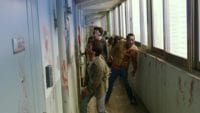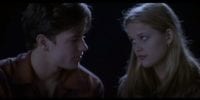Horror and comedy, under the right circumstances, can go together as well as peanut butter and chocolate, or Disney and dropping the ball on sequels to famous movie trilogies. We here at 25YL love a good horror comedy, be it classics like Evil Dead 2 or more modern hits like Tucker and Dale Vs. Evil. The weird thing about this genre, though, is that movies within it tend to be either/or. What I mean by that is that they either function as comedies with horror elements thrown in (the most common example of the subgenre), or they’re straightforward horror movies that happen to have comedic elements. For instance, despite how balls-to-the-wall loony and gory something like Dead Alive is, it is functionally a comedy because the gore is often used as a punchline.
Enter the John Dies at the End book series. Written by David Wong (the pen name for Jason Pargin), the at-time-of-this-writing trilogy has been able to completely reinvent itself with each installment, tapping into very real, primal fears that humanity will never admit to having while also making the reader laugh his/her ass off. The John Dies at the End series is more than just a horror comedy. It is, instead, a merging of the two separate genres in that each part exists within the same space. The funny moments serve to highlight just how terrifying the monsters the characters go up against really are, but the horror also makes the comedy feel like a cathartic release every time it lands.
Let’s take a look at each book in the series and how it uses comedy to inform the horror and vice-versa.
John Dies at the End
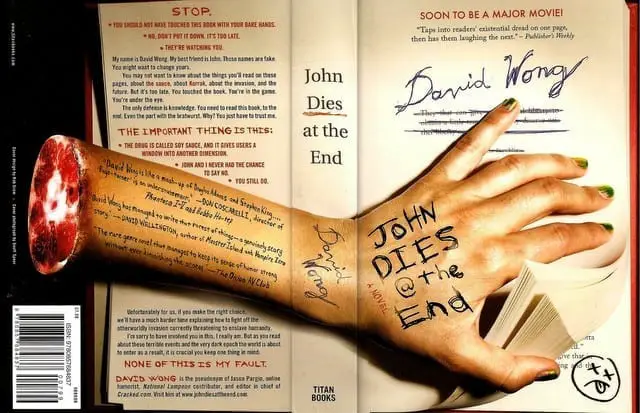
Starting its life as a series of stories concerning John and Dave, two slackers from a town simply known as Undisclosed, this first installment could be considered rough compared to the following two. It’s extremely episodic, meaning that filmmaker Don Coscarelli really had his work cut out for him when he made a film adaptation a few years after this released (it has its problems and is rather messy because it cuts out a lot from the shockingly dense novel, but it’s entertaining enough). The book’s first major arc involves John and Dave running afoul of a new drug that’s hit the street, called Soy Sauce. John bought it from a black man who called himself Robert Marley who was at a show where John’s band was playing.
As it turns out, though, Soy Sauce isn’t really a drug at all. Instead, it’s an alien substance that allows users to transcend the rules of space and time when they take it, as well as see things like ghosts and spirits for the rest of their lives. This rather loose setup lets Wong really play with the rules of reality as we know it, with a very early, particularly sublime scene involving Dave talking to John through a sausage he bought off the street (it’s complicated).
As it turns out, one of the locals is possessed by a bunch of spirits (this possessed person calls themselves Sh!tload and loves listening to Limp Bizkit) and is hatching a plot to use a gala as a means of invading this plane of existence. It opens the door for the book’s larger plot, which is stopping the gradual otherworldly invasion of a legion of alien-demon things who serve a Lovecraftian being known only as Korrok. Many of the following stories tie into that larger arc, with the book eventually culminating in an otherworldly trip to Korrok’s realm through a door in the local abandoned mall.
In case you can’t tell, the book is filled with hopelessly stupid, but very funny moments that help bring some levity to the rather disturbing ideas it presents. Shortly after stopping the invasion at the gala, John and Dave become quasi-exterminators, performing odd jobs around town for people who are seemingly suffering from supernatural phenomena. Their first case is one of a woman who is mad at a dark stain that keeps appearing on her floor. Every time she cleans it up, it reappears at the same time the next day. Because John and Dave have both taken Soy Sauce, they are able to see it’s because there’s a ghost that screams into eternity on her floor and bleeds out from his crotch because he was shot in the junk and killed. It’s a darkly funny scene, especially when John’s only idea to break the cycle is to yell at the guy that he’s dead. But it takes a turn when Dave considers the idea of reliving your final moments over and over.
There are very obvious cosmic horror elements at play here, and like the best of cosmic horror, it poses big, terrifying questions about the very nature of human existence. In the book’s first arc, near its end, Dave has flashes of a man no one in the group he’s with can remember. He has very vague echoes of a guy they all knew in high school who was swept up in the mayhem, and he gets the idea that there’s a hidden group of shadow people who are sometimes able to reach out and erase somebody from existence. Not just kill them, but somehow go back in time and make it so they were never there. That’s almost a scarier idea than complete annihilation upon death, and Dave only has a few brief glimpses of this man that may or may not have once existed.
There are some pretty big spoilers ahead, so if this is something you’re interested in reading, skip the next few paragraphs and go on down to the part about the series’s second entry.
Perhaps the biggest question the book poses is one of personal identity. Because the book is presented as a series of interconnected stories, the wrap around is a journalist named Arnie speaking with Dave at a local Chinese restaurant. He’s a short, stocky white guy that talks in a nasally, high-pitched voice, and throughout the book drops hints that he views himself differently from how Dave sees him. Dave reveals near the end that’s because he is only real because Dave desired an outlet to offload all of his crazy stories. Dave looked the guy up, and he died a while ago. He asks Arnie what he thinks he looks like, and Arnie says that he’s a large black man. When Dave shows him a mirror, Arnie sees that he’s a short white nerd because that’s how Dave thought he looked based off the sound of his voice. Arnie then screams before disappearing from existence.
The book opens with a monologue from Dave describing his decapitation of a possessed neo Nazi. He goes through the details of burying the guy, the axe he used breaking, replacing the blade and eventually the handle, and the neo Nazi rising from the dead, bursting through the door, and screaming, “THAT’S THE AXE THAT KILLED ME.” Dave then poses the question: is he right? If you replace every part of an object, but its function is the same, is it really the same object? How can it be if every part is different?
This initially seems like a one-off joke designed to set the tone, but it’s actually foreshadowing for what comes later. About halfway through the book, Dave wakes up from a mysterious blackout and finds a body that he refuses to acknowledge covered up in his shed. As it turns out, the body is him. A major plot thread is the idea that Korrok has been sending body doubles of people who live in Undisclosed and replacing them with his own versions of them for nefarious means, and they’re indicated by a tattoo of Korrok’s symbol on their heel. Sure enough, Dave checks his heel, and he has the very same mark. He is an evil double of the Dave we meet in the beginning of the story, with all the memories of real Dave intact. It brings everything back around to that opening monologue: if this Dave looks the same, sounds the same, thinks the same, has all the same memories, but is actually a copy, is it still Dave?
For a book filled with too many d*ck jokes and obscenities to count, it still manages to get under the skin due to these ideas it poses. Oftentimes, the humor and horror occur in the very same page, and the effect it creates is essentially a giant middle finger to our own frail existence; Wong presents us with existentially terrifying ideas, and makes us laugh at them. Underneath the juvenile humor and over-the-top violence is a way to scare the crap out of the reader by making them ponder questions that seemingly have no right answer. And as we will see, it wasn’t the last time he would do such a thing.
This Book is Full of Spiders: Seriously, Dude, Don’t Touch It
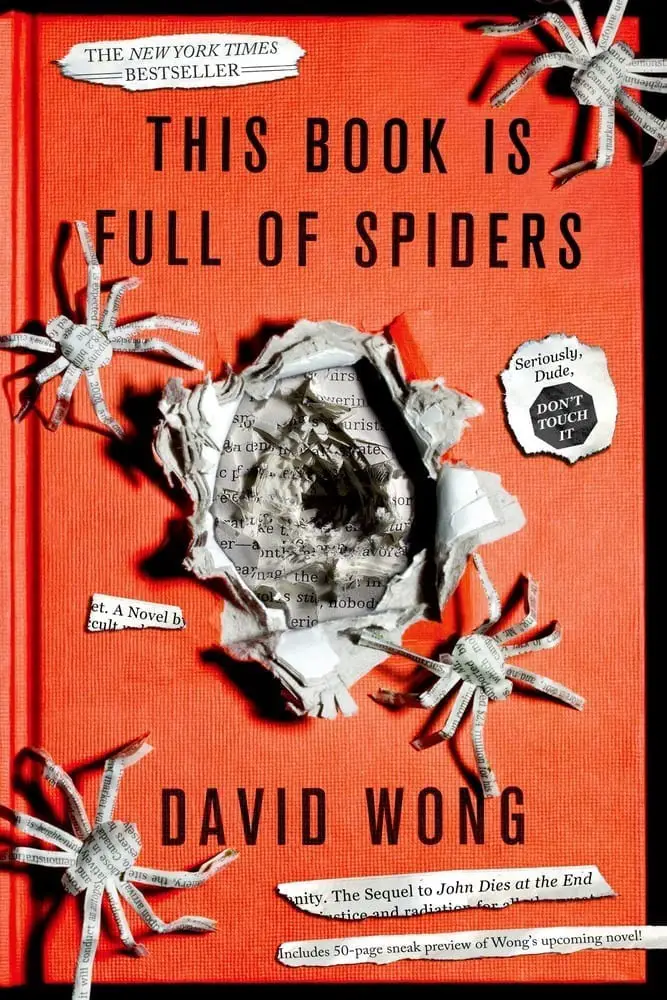
The sequel to John Dies at the End is arguably much more well-crafted than its predecessor, and that’s because it was actually written as a proper novel rather than a series of interconnected stories that were posted online through the course of several years. And rather than tackling the same type of subject matter, This Book is Full of Spiders instead reinvents the world and becomes a full-on, somehow-relevant zombie story, which is all the more impressive considering it was released at a time where the market was oversaturated with zombies.
John, Dave, and Amy (who Dave began dating at the end of the first book) have been trying their best to move on with their lives, and Amy has begun attending a nearby college, but before long, the trio are swept up in a plot that threatens all of Undisclosed, and eventually the entire world. See, someone has released spiders from another dimension into Undisclosed. These spiders are invisible to most, although, of course, John and Dave are able to see them due to the residual effects of the Soy Sauce. The spiders can live inside any orifice for however long they want before taking over the host’s brain and physically changing them into monsters. It isn’t long before Undisclosed becomes a war zone, with citizens being quarantined and paranoia running rampant.
Like the best of zombie fiction, This Book is Full of Spiders touches on the idea that humans are the real monsters. There’s evidence of this all over the book; all of the main trio are separated early on, with Dave having been put in a quarantine camp, where he witnesses a mini-hierarchy rise among the prisoners. People turn on each other quickly, and others wind up getting killed because of a misguided notion of heroism and badassery (Amy’s plot line sees her teaming up with a group of college-age survivalist enthusiasts, and it culminates in one of the book’s most intense scenes).
But here, Wong has put a unique supernatural twist on the idea of zombies. Like in most stories of the subgenre, characters believe this is a viral infection and that contact can spread whatever condition it is that turns people into monsters. But as Dave, and the reader, knows, it’s actually much more terrifying—people who are carrying the arachnid parasite don’t even realize it until it’s too late, meaning anyone at any time could be a real threat.
The book uses a concept known as Dunbar’s Number to explain how this paranoia can take seed so quickly in a small town like Undisclosed. The idea is that people are only mentally capable of caring for a very certain number of people, maybe a maximum of 150 or so, and that they subconsciously “other” everyone else. It’s a scary, but interesting idea that has real world application. It explains the “us” vs. “them” notion that permeates modern politics, or even how kids form their own small groups in school and typically stick to them. This is portrayed in the book as a direct cause of all the violence and paranoia that infects the community.
That being said, it’s also a very, very funny book as well. John’s idea of a prison break is ramping a Cadillac that only plays one Creedence Clearwater Revival song through its tape deck over the prison fence; there are chapters narrated from Dave’s dog, Molly (a returning character from the first book who has partaken in Soy Sauce and, as such, has done things like drive a truck through the front of a burning building), where she refers to Dave, her “master” as “meatsmell”; and Amy is an adorably awkward but smart character throughout, and arguably winds up being one of the major catalysts for saving the day.
Whereas the first book touched on the idea that our own sense of being is shockingly fragile, this book instead plays on the inherent mistrust we have for our fellow human beings. It takes every day prejudices and exaggerates them to comical but scary effect, showing how easily people turn on each other when push comes to shove. Unlike the first book, which mostly leaves the questions it poses unanswered, this book does have an answer to this in the form of its resolution. The entire town comes together in a very literal sense to form the shape of a giant penis in order to signal to the bombers about to wipe out Undisclosed that there are survivors down on the ground. Crude? Yes. But also weirdly inspirational and positive.
What the Hell Did I Just Read?
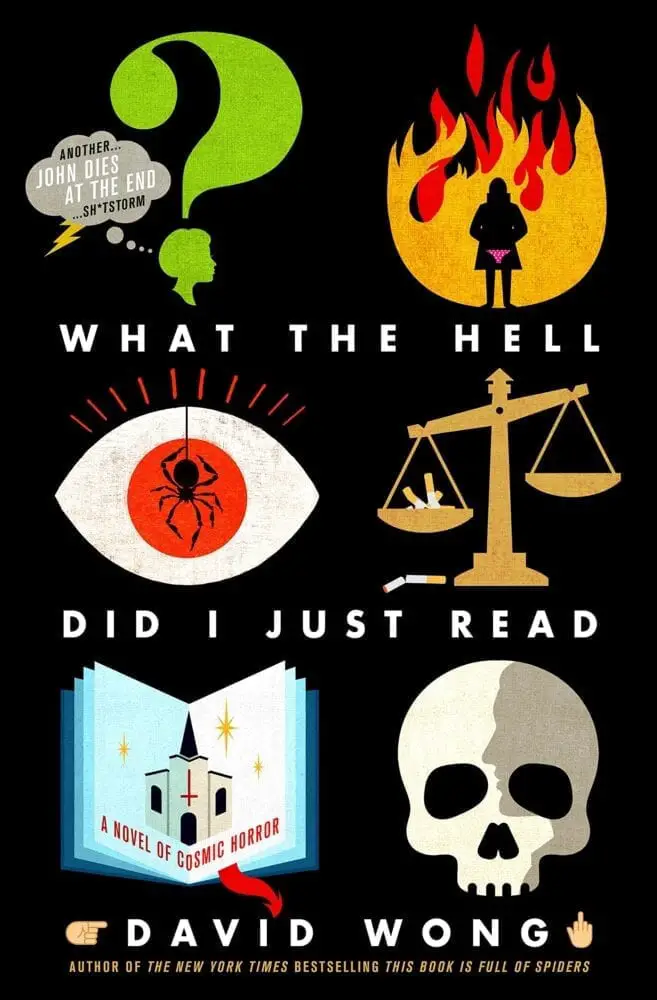
This book, moreso than the other two, is difficult to discuss without getting into spoilers, so consider yourself warned. I won’t be discussing details from the very end, but there’s a lot packed in here that works best when you don’t know what’s coming.
Anyway, if the first book is about humanity’s fragile mortality and sense of being, and the second book is about how quickly people can turn on each other and how they can be their own enemy without even realizing it, What the Hell Did I Just Read? is a book about how tenuous memory can be, and how it can, more often than not, work against us. It begins with a seemingly innocuous but chilling case (or “screaming clown d*ck,” as John likes to refer to situations that require their ability to see the other side). A war veteran says that his daughter went missing from a locked room, and he wants John and Dave to help him find her, because he was approached by a supposed pervert who told him that his daughter would go missing. Also, there’s a mysterious creature that locals have dubbed BATMANTIS??? running around capturing other children, who are going missing all over town.
John and Dave both believe that it’s the work of a horrible killer and that, awful though it may be, it’s a situation best left handled by the cops. That is, until they’re approached by a woman who is able to get her son back who then tells them that she didn’t have a son until yesterday. There are holes in her memories where there shouldn’t be any, and after John and Dave decide to take more Soy Sauce to try and get to the bottom of things, they’re able to see that this woman is right. All of the missing children are actually bizarre, grub-type things that are feeding off the energy of these parents who aren’t actually parents.
This is a similar premise to the Rick and Morty episode “Total Rickall,” where the Smiths are inundated by an alien parasite that makes them believe all the whacky characters that have popped up in their house are actually beloved members of their family. This book, though, takes it all a step further by upping the stakes and adding in a huge helping of gore. It raises the question of what makes our relationships real. Is it that we’ve known someone for so long? Or is it that we think we have?
It’s one of the scariest concepts the series has introduced yet. In the late parts of the book, parents of the “missing children” go to great lengths to try and get them back, and John, Dave, and Amy have no way of knowing how to prove to them that the things they think are their offspring are actually parasites hellbent on taking over our reality. And who can blame them? Though I’m not a parent myself, I know many people who are that would do anything for their kids. I know I would absolutely go into full John Wick mode for my dog if the need should arise, although it’d be a much sweatier, floppier version of John Wick.
It also forces the reader to look at the craziness that’s going on through a different perspective than the chronically depressed and pessimistic Dave. From the parents’ point of view, John and Dave are actively trying to kill their kids, so it makes complete sense that they would behave the way they do near the end of the book. It makes a scary and bold claim: our memories are only real because of the meaning we give to them, and more often than not, those very memories that make up who we are are very easily manipulated.
But like the other books, it asks all of these questions with a wicked, stupid grin on its face and manages to punctuate the terrifying ideas at play with humor. An early instance is how John has supposedly adopted a dog named DEE-OH-GEE, and how that dog then turns out to be, you guessed it, a parasite. There’s a very brief passage early on where Dave questions when he got the dog, but because he’s John, he brushes it off. The man is resourceful, to say the least. There’s also the fact that Dave and Amy live above a sex toy shop, and when they come to from their Soy Sauce blackout, John is trying to cut off Dave’s face using a dildo (the chapter this occurs in is called “The Great Dildo Flood,” in case you were wondering).
Like the other two books, What the Hell Did I Just Read? asks questions that don’t really have answers, at least not that our pathetic human brains can comprehend. It’s indicative of the series as a whole, and also taps into why people love horror in the first place. The book, and the whole series, recognizes how fragile we as beings really are. We’re insecure, and ultimately insignificant when weighed against all of existence, and even though it shoves that in our face, it also makes us laugh at those ideas time and time again. It’s why I, and many others love horror so much. It allows us to confront the weakest parts of ourselves and the grandness of our flaws by staring them in the face, then turning around and farting in said face. It’s what makes this series so special—we may not mean much in the grand scheme of things, but that doesn’t mean we can’t have a lot of laughs while we’re here.

